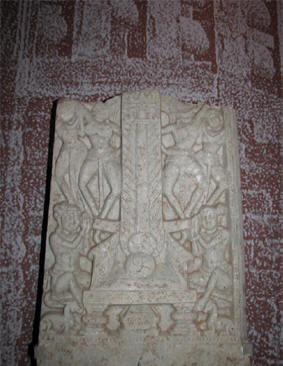|
 
Left: Christmas tree in Piazza
Portanova, Salerno old town, Italy.
11 December 2008.
© SOLOXSALERNO, courtesy Wikimedia
Commons. Right: Buddha represented
as Agniskanda or ‘pillar of fire’,
surrounded by worshippers. From
Amaravatī, Andhra Pradesh,
India (first century CE). Courtesy
Asian Civilisations Museum,
Singapore.
O Christmas Tree! Thy Candles
Shine So Brightly!
Dec 24, 2010
That the Christmas tree did
not originally root in Christian
symbolism has never been a secret.
The custom to erect a Christmas
tree during the winter solstice,
sustaining a reminder of the
summer’s verdancy and abundance of
sunlight through the heart of
winter, is of ‘pagan’ origin, but
its antiquity and former geographic
distribution remain knotty subjects.
Like the Maypole, the earliest
historical references to the
Christmas tree date from the
fifteenth or the fourteenth century
CE, but unlike it, the practice to
set up and decorate a Christmas tree
at that time appears to have been
limited to a small part of Europe –
first the Baltic region and then
also northern Germany.
As is true of so many other
branches of folklore, the late
attestation of the ‘ritual’ does not
necessarily imply a recent origin.
For earlier epochs, the historian
faces a dearth of texts discussing
popular domestic topics and –
especially in eastern Europe – a
predominantly pre-Christian setting,
within which references to
non-controversial aspects of daily
life may be expected to be sparse.
Against this background, there is
every chance that the preparation of
a Christmas tree was an old and
ingrained part of traditional
culture in northeastern Europe. If
it was, the many conifers so adorned
may have represented a single
mythical prototype and the discovery
of global analogues to the
veneration of such a mythical ‘tree
of light’ carries clout.
A brief survey of luminiferous
trees in mythology reminiscent of
the Christmas tree could hardly fail
to acknowledge two passages in the
Icelandic Edda, in which the
numinous ash Yggdrasil was lauded as
'the radiant, sacred tree' and 'a
high tree, soaked with shining
loam'. The central textbook of
Qabbala, the medieval Jewish work
entitled Zohar, owed its name
to the luminosity of the ‘tree of
life’, which doubled as the central
axis in the scheme of the
Sephirot:
'In this tree exists one radiancy:
zohar, radiance, all colors
inhering there. Those colors ascend
and descend, not settling anywhere
except in that tree. When they issue
from it to appear in the radiance
that does not shine, they settle and
do not, endure and do not – for they
settle nowhere else'.
Indeed, for adepts of this brand
of mysticism the tree 'is the Sun
which illumines all. Its radiance
commences at the top and extends
through the whole trunk in a
straight line'. Further afield, the
Omaha, of Nebraska, tell of 'a
luminous tree' frequented by the
Thunder birds: 'When the Thunder
birds alight upon the tree it bursts
into flame and the fire mounts to
the top. The tree stands burning …'
The Nlaka´pamux nation, of British
Columbia, contend that the world
received its first light from a
magical tree that possessed an
intrinsic luminosity and was then
incinerated:
'A very large dead tree grew on a
hill called Yeqatwa’uxus cuxcu’x,
near Spences Bridge. It was endowed
with magic, and in some manner
possessed light. At that time it is
said the world was always dark. The
Chipmunk did not like the continual
darkness, and, going to the tree,
set fire to its roots. He kept the
fire going, and, as the tree burned,
light commenced to come'.
While Balto-Finnish ancestors of
the Christmas tree also used to be
ritually burned, many other parallel
traditions attribute the light to
smaller units of fire, often
compared to suns, gems or flowers,
that were distributed across the
tree like Christmas lights are today
from Alaska to New Zealand.
Hindū literature knows of 'a
golden wish-tree, decorated with
gems, shining like the sun', which
is variously called Kalpatura,
Kalpavṛksa or Pārijāta.
This entity may trace to an early
Vedic belief in a fiery
heaven-spanning tree from whose
branches the gods as the 'other
fires' were suspended like baubles
on a Christmas tree – 'to be a light
unto the Ārya'.
In the early days, the flaming
pillar had been personified as the
fire god, Agni, who 'like a builder
raised his smoke to heaven … Eager
he rises like the new-wrought pillar
which, firmly set and fixed, anoints
the victims'. Later, Buddhists would
represent their hero, the Buddha, as
'a fiery pillar, with wheelmarked
feet, supported by a lotus, and with
a triśula "head" …' In Chinese lore,
the giant tree known as fú sāng
or 'support mulberry' was stated to
be the place 'where the ten suns
were bathed:'
'In the water is a large tree
with nine suns in the lower branches
and one in the upper'.
A commentator added to this: 'In
the top of the jo tree
are ten suns, resembling flowers
strung together, casting light
downward'.
Meanwhile, the native people of
Kédang, one of Indonesia’s Lesser
Sunda Islands, preserved memories of
ai werén,
the 'tree of gold', so called
because its 'blossoms were golden
chains (abalodon),
its fruits were golden earrings (laong
werén) …' And members of the
Iroquois confederation, of
northeastern North America, held
that the flowers of a tree supplied
the only light during the first of
the 'three great mythic cosmic
periods' that have existed, before
today’s luminaries had been placed
in the sky; they would speak of 'the
sunless and moonless skyland,
lighted only by the snowy white
flowers of the great tree of light
…' Thus, the creation myth of the
Seneca, in New York State, involved
'a tree which was covered with white
blossoms' growing in 'the middle of
the village in the sky', 'in the
center of the sky above', where the
first people used to live:
'When this tree was in bloom its
flowers gave light to the people
there, but when its flowers fell,
darkness came over the people. … the
tree was sacred to them.'
An Onondaga variant of this myth
reveals Ono’´djă’ or 'Tooth'
as the name of the tree:
'… And there beside the lodge
stands the tree that is called
"Tooth." Moreover, the blossoms this
standing tree bears cause that world
to be light, making it light for the
man-beings dwelling there. Such, in
kind, is the tree that stands beside
the lodge. … beside the lodge stood
the tree Tooth, whose flowers were
the source of the light of the earth
there present, and also of the
man-beings dwelling there'.
For the Mohawk the heavenly tree
'belonged to the species wild cherry
… and was constantly adorned with
blossoms that gave light to the
people dwelling there; for these
flowers were white, and it was
because of this that the blossoms
gave light, and, therefore, they
were the light orb [sun] of the
people dwelling there'.
Candles and other lights aside,
several other properties of the
Christmas tree resonate with global
ideas about hallowed trees. The
‘angel’ or star crowning the tree
brings to mind the supreme deity at
the pinnacle of the axis mundi,
often conceived as a sun or a star.
Garlands and ribbons draped around
the tree resemble the respective
vines, ropes and ‘serpents’ wrapped
around the column in helical form.
The choice of an everlasting tree
could hardly be separated from the
world tree as an emblem of life,
immortality and durability. Baubles
compare to spirits and deities
inhabiting the tree’s branches. The
decoration of the tree with
communion wafers, paper roses,
apples, and so forth, as was common
in medieval Germany, meshes with
cross-cultural rituals involving the
dispersion of ‘goodies’ from a
cosmic tree.
With so many similarities with
the sacred trees of non-European
cultures it is easy to miss the
forest for the trees. Yet the bottom
line is that a unified image appears
to have existed worldwide of a
‘tree’ reaching into the sky that
supplied light to the world during a
time of persistent darkness and
displayed a number of discreet
structural forms.
As the earliest precursor to the
Christmas tree was mentioned in 1441
in Livonia and Livonia only
converted to Christianity in the
early 13th century, there is a
strong case that the Christmas tree
was a local, possibly Finnish reflex
of this universal theme. Elaborate
legends and rituals involving trees,
many of which immortalised by the
writings of the great Romanian
mythologist, Mircea Eliade
(1907-1986), flourished throughout
the Arctic world and the Balto-Finnish
Christmas tree may just represent a
western outlier of this continuum.
As argued in many of our
publications, the global memory of a
blazing ‘tree’ in the dark sky
preceding the time of ‘creation’
seems to have arisen in response to
a low-latitude aurora of an
extraordinary intensity which
remained visible for a prolonged
time during the late Neolithic
period. Computer models and
analogies with plasma z-pinches in
laboratories suggest that this
aurora for much of its existence
took the form of a giant column
sprouting dendritic lightning-like
branches. Plasmoids and spiralling
filaments formed in the column would
produce a spectacle quite like that
of a tree ornamented with baubles
and ribbons. Hence, human
eyewitnesses of this remarkable
display, seemingly orchestrated by
the gods, might well have been moved
to sing:
'From base to summit, gay and
bright,
There’s only splendour for the
sight!
…
How richly God has decked thee!'
Rens Van Der Sluijs
http://mythopedia.info
Books by Rens Van Der Sluijs:
The Mythology of the World Axis
The World Axis as an Atmospheric
Phenomenon
Multimedia

Debunking Misconceptions About
the Electric Universe
|









